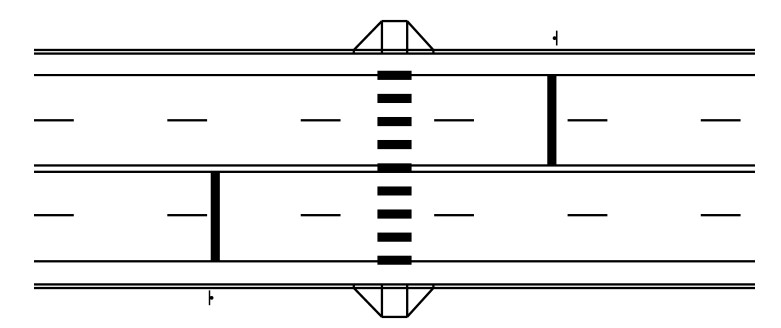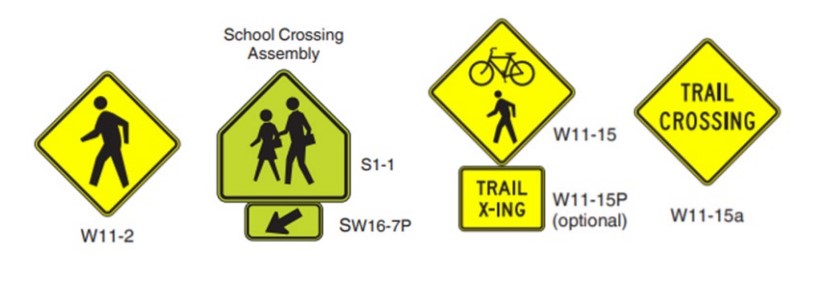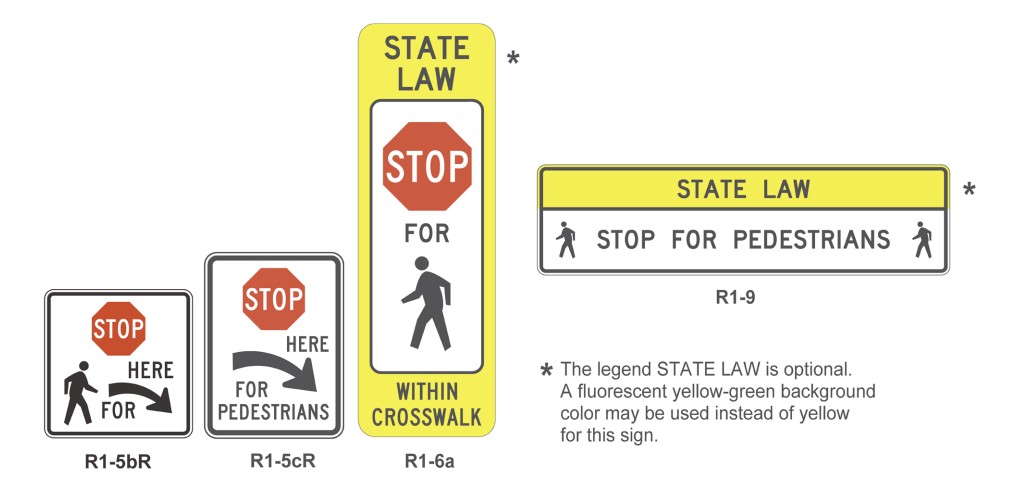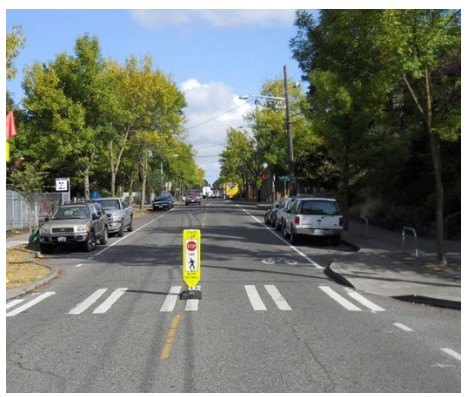19.6.4 Uncontrolled Crossing Safety Countermeasures
Uncontrolled crossing locations are those where sidewalks or designated walkways intersect a roadway at a location where no traffic control (i.e., traffic signal or STOP sign) is present. These may be at intersection or midblock locations.
19.6.4.1 Marked Crosswalks with Uncontrolled Traffic Movements
As discussed in
, motorists must stop and yield the ROW to crossing pedestrians who are lawfully within a marked or unmarked crosswalk at intersections or at marked crosswalks at midblock locations. Marked crosswalks visually communicate to both pedestrians and drivers that pedestrian crossings are expected at that location and remind motorists of their responsibility to stop and yield to pedestrians.
19.6.4.1.1 Application
Marked crosswalks indicate optimal or preferred locations for pedestrians to cross and remind motorists to stop and yield the ROW to crossing pedestrians. They may be installed at any intersection location where it is desired to support pedestrian crossings.
In general, marked crosswalks and other safety treatments should be prioritized at locations where pedestrians desire to cross the street and are vulnerable to conflicts with vehicles such as locations with:
- High pedestrian and vehicular volumes;
- Locations where pedestrians are routinely expected typical of urban areas, rural town centers, school zones, parks, university or other similar pedestrian intense institutional land uses, or at bus stops;
- Locations with vulnerable populations such as children, senior citizens, people with disabilities, or hospital areas;
- Locations where traffic or geometric conditions make it difficult for pedestrians to cross creating safety challenges for pedestrians; and
- Locations with shared use path or trail crossings.
Marked crosswalk research shows that they are an effective treatment to increase motorist awareness of pedestrians and to improve understanding of ROW compared to unmarked crosswalks. However, this research also shows that marked crosswalks used alone may increase pedestrian crash risk if not used with other supplemental engineering treatments at uncontrolled crossings where the speed limit exceeds 40 mph and either:
- The roadway has four or more lanes of travel without a raised median or pedestrian refuge island and an ADT of 12,000 vehicles per day or greater; or
- The roadway has four or more lanes of travel with a raised median or pedestrian refuge island and an ADT of 15,000 vehicles per day or greater.
At these locations, it will be necessary to install other measures to reduce traffic speeds, shorten crossing distances, enhance driver awareness of the crossing, and/or provide active warning of pedestrian presence to supplement the marked crosswalk following the guidance in
.
A marked crosswalk is required to legally establish the midblock crossing per
.
19.6.4.1.2 Design Parameters
Marked crosswalks must follow
and further guidance found in
Section 3B.18.
shows an example of a typical marked crossing

Figure 19-28: A Marked Crosswalk (Controlled Crossing)
19.6.4.1.3 Considerations
Supportive Traffic Control Signs
- Regulatory and warning traffic signs (see
) may be used at and in advance of a crosswalk where pedestrians may be unexpected, and it is desired to improve visibility of the crossing.Standard markings will incur wheel wear and need to be maintained over time. Longitudinal crosswalk markings should not be in the wheel path of vehicles. Center the crosswalk lines on travel lanes, lane lines, and shoulder lines (if present) to reduce wear, and thus reduce the need for maintenance. To provide better visibility on concrete roadways, the white crosswalk markings may be outlined with black contrast markings.
19.6.4.2 Stop Bars and Yield Lines
Stop bars (a.k.a. stop lines), yield lines, or advance yield markings improve safety at uncontrolled crossings on multilane roadways by improving visibility and decreasing the possibility of a multiple threat collision. These lines reinforce a driver’s responsibility to stop and yield to pedestrians in a crosswalk at an uncontrolled location or stop and yield condition movement within a signalized intersection, (e.g., a channelized right turn lane). Stop bars or yield lines are those placed in advance of a marked crosswalk. Refer to
Section 3B.16 and Figure 3B-17.
provides an example of a marked crosswalk at an uncontrolled intersection.
19.6.4.2.1 Application
See
and
for application. Because they are effective at mitigating multiple threat crashes, they should be considered at all marked, unsignalized crossings of multi-lane roadways. They may be used on single lane approaches to marked crosswalks where engineering judgment determines a need.
19.6.4.2.2 Design Parameters
Refer to Section 3B.16 of the
and the current
for further design guidance.
19.6.4.2.3 Considerations
Parking should be restricted on both sides of the street between the stop bars and yield line markings and the marked crosswalk to improve visibility. Refer to Section 3B.16 of the
for further guidance.
Stop bars may be staggered across lanes if appropriate.
“PED XING,” “SCHOOL XING,” or “TRAIL XING” pavement markings may be placed in advance of the stop bar pavement markings to identify the purpose of the stop bars is a crossing along with a corresponding warning sign.

Figure 19-29: Stop Bars at a Marked Crosswalk (Uncontrolled Crossing)
19.6.4.3 Supportive Signs
The functions of signs are to provide regulations, warnings, and guidance information for road users. They can be supplemented with markings. Any information intended for pedestrians must be accessible to all pedestrians. The following discussion focuses on the most common signs needed to support engineering treatments in this chapter. The
describes the use and application of other signs not discussed which may be beneficial to accommodating pedestrians.
Wayfinding is discussed in
below
19.6.4.4 Pedestrian Crossing Warning Sign Assemblies
19.6.4.4.1 Application
Pedestrian traffic warning signs should be used at and in advance of a marked or unmarked crosswalk to notify motorists of the crossing and improve visibility of the crossing as a baseline treatment to marked crosswalks. See
and
for application. The message should reflect the type of crossing (pedestrian (W11-2), school (S1-1), and trail (W11-15 or W11-15a)). See
.They should be used at all marked, uncontrolled crosswalks. Refer to
Section 2C.50 for guidance and standards for use. School zone traffic control is further covered in Chapter 7 of the
.

Figure 19-30: Pedestrian Crossing Warning Signs (left to right): Pedestrian Crossing, School Crossing, Pedestrian and Bike Trail Crossing, and Trail Crossing.
19.6.4.4.2 Considerations
Signs may be mounted back-to-back on the same sign post to allow double posting of signs on the left and right side of the road to improve visibility to approaching motorists. Signs should be such that visibility is not obscured by other signs, utility poles, buildings, or vegetation.
An advanced placement of these signs should be considered in locations where sight distance is obstructed, or the crossing may be unexpected following the guidance of
Section 2C.05.
Beacons or flashers can be used to supplement warning signs and can be mounted Table of Contents Instructions Reference Links Roadway Design Manual | 19-54 on the sign post with the warning sign or over the crossing. They can flash continuously or be actuated by a pedestrian waiting to cross; however, these signs have been shown to be more effective if actuated. Actuation can occur when a pedestrian uses a pushbutton or through passive detection such as infrared. Wherever pedestrian actuated systems are installed, they should be accessible.
19.6.4.5 Pedestrian Crossing Regulatory Sign Assemblies
19.6.4.5.1 Application
The “Stop Here for Pedestrians” series signs (R1-5b, R1-5c, R1-6a, and R1-9a) may be used to notify approaching motorists of their responsibility to stop and yield to crossing pedestrians at uncontrolled crossings. See
and
for application. Refer to Section 2B.11, 2B.12, and Section 3B.16 of the
for further standards and guidance.
shows the current signs at the date this manual was published.

Figure 19-31: Unsignalized Pedestrian Crossing Signs.

Figure 19-32: Pedestrian Stop Sign at an Uncontrolled Intersection.
19.6.4.5.2 Considerations
In-street Stop for pedestrian sign (R1-6a) have been found to be effective at increasing motorist stopping rates on roadways operating at 30 mph or less with ADT of 25,000 or less (see
).
19.6.4.6 Rectangular Rapid Flashing Beacon
A Rectangular Rapid Flashing Beacon (RRFB) is a device that supplements a warning sign that consists of amber LEDs that use an irregular flash pattern to draw roadway users’ attention to a crossing when a pedestrian is present. They may supplement any of the warning signs discussed in
. RRFBs are generally actuated with a pedestrian push button but may also be activated through passive detection. The pedestrian push button or passive detection device shall activate a speech message that indicates the status of the beacon (e.g., “Flashing lights are on”). If the pedestrian push button is used, it shall not include vibrotactile features as this feature communicates that walk indication is provided for a pedestrian signal.
As of September 11, 2018, RRFBs have interim approval for use across Texas though they do not appear in the current (2011) edition of the
. Contact the TRF for specific guidance on the use of RRFBs. As of the publishing of this manual, the link for interim approval of RRFBs can be found in the
19.6.4.6.1 Application
RRFBs can be used at and in advance of an uncontrolled marked or unmarked crosswalk to notify motorists of the crossing and improve visibility of the crossing as a baseline treatment at locations where static signs or flashing beacons are not sufficient to induce motorist stopping and yielding. See
and
in
for application.
19.6.4.6.2 Considerations
On multi-lane roadways, consider the visibility of roadway edge signs to drivers in the middle lanes. Where a median island is present, placement of additional RRFB assemblies there may increase visibility and thus stopping and yielding compliance. RRFBs may also be placed in advance of the crossing on higher speed roadways or at locations with sight distance restrictions providing motorists sufficient time to react to the device to slow and stop and yield to crossing pedestrians. The advance sign(s) can be designed to wirelessly communicate when the crossing is actuated. The R1-5b signs and advanced stop bar markings may also be used with the RRFB. Care should be taken such that R1-5b signs do not restrict motorists’ view of the flashing beacon at the crosswalk.
shows an example of an RRFB.
Solar-powered assemblies can eliminate the need for connecting to a power source.
Figure 19-33: Rectangular Rapid Flashing Beacon.